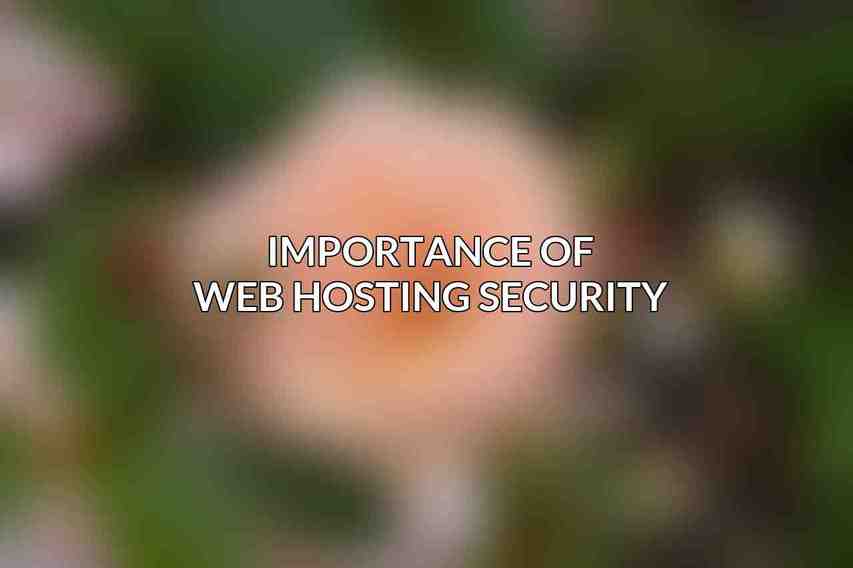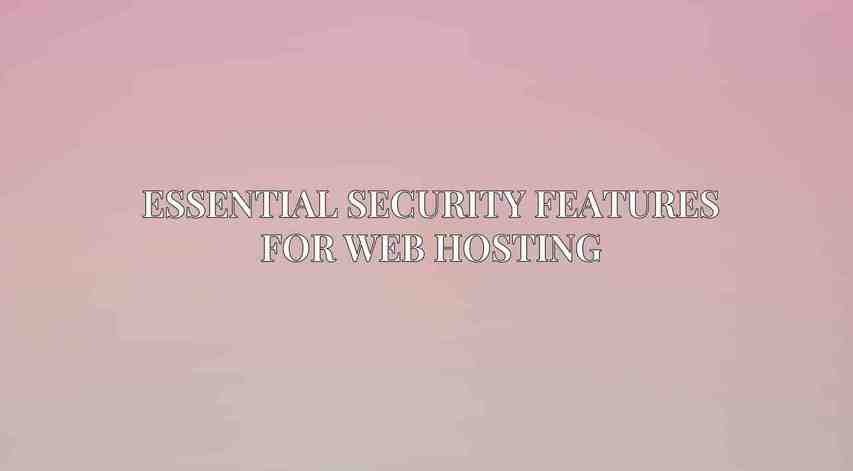In an era where digital presence dominates the global world, ensuring the security of websites and online data has become paramount. The sophistication of cyber threats continues to evolve, emphasizing the critical need for enhanced security measures in web hosting services. As we navigate through 2024, it is imperative to explore and implement the essential security features that safeguard websites against a myriad of vulnerabilities and attacks.
Importance of Web Hosting Security

Web hosting security plays a pivotal role in safeguarding data, maintaining trust with users, and upholding the integrity of online platforms. A secure web hosting environment is a prerequisite for protecting sensitive information, preventing unauthorized access, and ensuring uninterrupted online operations. Explore further with How to Choose a Secure Web Host: A 2024 Buyer’s Guide
Evolving Cyber Threats and the Need for Enhanced Security Measures
The digital world is constantly evolving, with cybercriminals employing increasingly sophisticated tactics to exploit vulnerabilities in web hosting environments. From ransomware attacks to DDoS assaults, the range of threats necessitates robust security measures to mitigate risks and safeguard against potential breaches.
Essential Security Features for Web Hosting

A. SSL Certificates
SSL certificates are a fundamental security component that encrypts data exchanged between a website and its visitors. The implementation of SSL certificates not only secures data transmission but also enhances credibility through the display of trust indicators such as the padlock symbol and HTTPS protocol.
- Encryption and Authentication: SSL certificates employ encryption algorithms to secure data in transit and authenticate the identity of the website.
- HTTPS Protocol and Trust Indicators: The presence of HTTPS in the URL and visual trust indicators reassure users of a secure connection.
- Types of SSL Certificates: Different types of SSL certificates, such as Domain Validated (DV), Organization Validated (OV), and Extended Validation (EV), offer varying levels of validation and security.
B. Web Application Firewall (WAF)
A Web Application Firewall is designed to protect web applications from a variety of attacks, including SQL Injection and Cross-Site Scripting (XSS). By monitoring and filtering HTTP traffic, WAFs serve as a frontline defense against malicious actors targeting web applications.
- Protection against Common Web Attacks: WAFs offer proactive defense against common web vulnerabilities, enhancing the security posture of web applications.
- Real-Time Monitoring and Response: Continuous monitoring and instant response mechanisms enable WAFs to identify and thwart attacks in real-time.
- Types of WAFs: WAF solutions come in various forms, including cloud-based and on-premises deployments, catering to diverse hosting environments.
C. Intrusion Detection and Prevention Systems (IDS/IPS)
Intrusion Detection and Prevention Systems function as vigilant sentinels, monitoring network traffic for suspicious behavior and actively blocking potential threats to prevent unauthorized access.
- Monitoring and Analysis of Network Traffic: IDS/IPS systems analyze network packets in real-time, detecting anomalies and potential security breaches.
- Detection and Blocking of Malicious Activity: By recognizing patterns indicative of malicious activity, IDS/IPS systems act promptly to thwart potential threats.
- Types of IDS/IPS Systems: Signature-based and Anomaly-based IDS/IPS systems employ different methodologies to identify and respond to security incidents effectively.
D. Malware Scanning and Removal
Malware scanning tools are indispensable for detecting and removing malicious software that can compromise website security and endanger user data.
- Detection and Removal of Viruses: Automated malware scanning tools detect and eliminate viruses, malware, and spyware, ensuring the integrity of the hosted content.
- Scheduled Scans and Automatic Quarantine: Regular scans and automatic quarantine capabilities prevent the proliferation of malware across the hosting environment.
- Integration with Popular Security Tools: Seamless integration with leading security solutions enhances the efficacy of malware scanning and removal processes.
| Type of Malware | Description |
|---|---|
| Viruses | Self-replicating malicious code |
| Spyware | Software that gathers data |
| Ransomware | Encrypts files for ransom |
E. DDoS Protection
Distributed Denial of Service (DDoS) attacks can disrupt online services, rendering websites inaccessible to legitimate users. DDoS protection mechanisms are vital for mitigating the impact of such attacks and maintaining service availability.
- Mitigation of DDoS Attacks: Robust DDoS protection solutions mitigate the impact of volumetric and application-layer DDoS attacks, ensuring uninterrupted service delivery.
- Proactive Monitoring and Response Measures: Real-time monitoring and automated response mechanisms enable timely mitigation of DDoS attacks before they cause significant harm.
- Types of DDoS Protection: DDoS protection solutions encompass cloud-based and on-premises approaches, tailored to address varying threat worlds.
F. Data Backup and Recovery
Data backup and recovery mechanisms are indispensable for safeguarding against data loss due to unforeseen events such as hardware failures, cyberattacks, or natural disasters.
- Regular Backups of Critical Data: Scheduled backups of critical data ensure that information remains accessible even in the event of data loss.
- Disaster Recovery Plan: A comprehensive disaster recovery plan facilitates swift data recovery and continuity of operations in the face of unplanned disruptions.
- Backup Options: Leveraging local, offsite, and cloud-based backup solutions provides redundancy and resilience in data storage practices.
G. Security Monitoring and Logging
Continuous monitoring of security events and the maintenance of detailed logs are essential for detecting anomalies, investigating incidents, and ensuring regulatory compliance.
- Real-Time Monitoring: Vigilant surveillance of security events in real-time enables prompt detection and response to potential threats.
- Forensic Analysis and Compliance Reporting: Detailed logs facilitate forensic analysis, compliance reporting, and post-incident investigations.
- Security Alerts and Notifications: Automated alerts and notifications keep stakeholders informed about security events and potential risks in the hosting environment.
H. Physical Security Measures
Beyond digital safeguards, physical security measures are vital for protecting data centers and infrastructure from unauthorized access and environmental risks.
- Access Control: Restricted access controls to data centers mitigate the risk of unauthorized entry and data tampering.
- Environmental Controls: Monitoring environmental factors such as temperature, humidity, and power management safeguards hardware and infrastructure integrity.
- Monitoring and Surveillance: Surveillance systems and monitoring tools enhance the security of facilities by detecting and deterring physical threats.
Advanced Security Features
A. Two-Factor Authentication (2FA)
Two-Factor Authentication provides an added layer of security by requiring users to provide two authentication factors for access, enhancing account security and mitigating the risk of unauthorized access.
- Enhanced Account Security: 2FA provides robust account security by necessitating multiple authentication factors for user verification.
- Support for Multiple Methods: SMS, email, and mobile app-based 2FA methods accommodate diverse user preferences and security requirements.
B. Content Delivery Network (CDN)
CDNs enhance website performance, scalability, and security by distributing content across a network of servers, reducing latency and fortifying against DDoS attacks.
- Improved Performance: CDNs optimize content delivery, accelerate page loading speeds, and enhance user experience.
- DDoS Mitigation: CDNs leverage distributed infrastructure to absorb and mitigate DDoS attacks, ensuring uninterrupted service availability.
- Security Enhancements: CDNs offer security features such as web application firewalls and bot mitigation to fortify against security threats.
C. Web Application Security Testing (WAST)
Regular security assessments, vulnerability scans, and penetration tests are essential for identifying and remediating web application vulnerabilities that could be exploited by malicious actors.
- Vulnerability Assessments: WAST evaluates web applications for vulnerabilities, misconfigurations, and potential security gaps.
- Penetration Testing: Simulating real-world attacks through penetration testing helps uncover exploitable vulnerabilities and assess the overall security posture.
D. Cloud Security Compliance
Adhering to industry standards and regulatory requirements is imperative for ensuring the security and compliance of cloud-hosted environments.
- Alignment with Industry Standards: Compliance with standards such as ISO 27001, PCI DSS, and GDPR demonstrates a commitment to data security and regulatory compliance.
- Proof of Compliance: Providing evidence of compliance through audits, certifications, and compliance reports instills trust and confidence in cloud security practices.
- Third-Party Validation: Third-party audits and certifications validate the adherence to security best practices and regulatory requirements, bolstering confidence in cloud security measures.
Summary of Essential Security Features
the world of web hosting security in 2024 necessitates a comprehensive approach that integrates essential security features such as SSL certificates, WAFs, IDS/IPS systems, and robust backup mechanisms to safeguard against evolving cyber threats.
Importance of Ongoing Security Monitoring and Updates
Continuous monitoring, regular security assessments, and timely updates are crucial for maintaining the efficacy of security measures and mitigating emerging security risks in web hosting environments.
Benefits of Choosing a Web Hosting Provider with Robust Security Measures
Selecting a web hosting provider that prioritizes security and implements a holistic security framework ensures the protection of data, the resilience of online platforms, and the trust of users in an increasingly digitized world.
As the digital world continues to evolve, investing in robust security features and staying vigilant against emerging threats will be imperative for ensuring the integrity, confidentiality, and availability of online assets. Embracing a proactive stance towards security will not only safeguard websites against potential threats but also foster trust and confidence among users in an era where cybersecurity is paramount. Learn more about 5 Essential Secure Hosting Best Practices for 2024
Frequently Asked Questions
What are some must-have security features for web hosting in 2024?
Some essential security features for web hosting in 2024 include SSL/TLS encryption, DDoS protection, regular security patches and updates, strong firewalls, and two-factor authentication.
How important is SSL/TLS encryption for web hosting security?
SSL/TLS encryption is crucial for securing data transferred between users and websites. It encrypts the data to prevent hackers from intercepting and reading sensitive information.
What is DDoS protection and why is it important for web hosting?
DDoS protection guards against Distributed Denial of Service attacks, which can overwhelm a website with traffic, causing it to crash. Having DDoS protection ensures that your website remains accessible during such attacks.
Why are regular security patches and updates necessary for web hosting security?
Regular security patches and updates help fix vulnerabilities in software and prevent cyber attacks. Failing to update can leave your website susceptible to exploits and breaches.
How does two-factor authentication enhance web hosting security?
Two-factor authentication adds an extra layer of security by requiring users to provide two different authentication factors, such as a password and a verification code sent to their phone. This significantly reduces the risk of unauthorized access.

